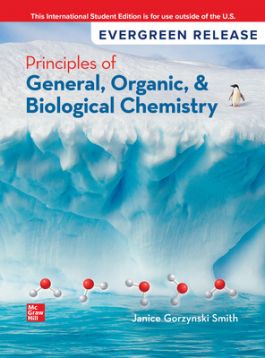Principles of General, Organic, & Biological Chemistry: 2025 Release ISE
1265703841
·
9781265703844
This textbook is written for students who have an interest in nursing, nutrition, environmental science, food science, and a wide variety of other health-related professions. The content of this book is designed for an introductory chemistry course w…
Read More
Request Review Access
Request More Info
Receive via shipping:
Colour, print bound version of the complete text
1. Matter and Measurement
2. Atoms and the Periodic Table
3. Ionic and Covalent Compounds
4. Energy and Matter
5. Chemical Reactions
6. Gases
7. Solutions
8. Acids and Bases
9. Nuclear Chemistry
10. Introduction to Organic Molecules
11. Unsaturated Hydrocarbons
12. Organic Compounds That Contain Oxygen, Halogen, or Sulfur
13. Carboxylic Acids, Esters, Amines, and Amides
14. Carbohydrates
15. Lipids
16. Amino Acids, Proteins, and Enzymes
17. Nucleic Acids and Protein Synthesis
18. Energy and Metabolism
2. Atoms and the Periodic Table
3. Ionic and Covalent Compounds
4. Energy and Matter
5. Chemical Reactions
6. Gases
7. Solutions
8. Acids and Bases
9. Nuclear Chemistry
10. Introduction to Organic Molecules
11. Unsaturated Hydrocarbons
12. Organic Compounds That Contain Oxygen, Halogen, or Sulfur
13. Carboxylic Acids, Esters, Amines, and Amides
14. Carbohydrates
15. Lipids
16. Amino Acids, Proteins, and Enzymes
17. Nucleic Acids and Protein Synthesis
18. Energy and Metabolism
<p>This textbook is written for students who have an interest in nursing, nutrition, environmental science, food science, and a wide variety of other health-related professions. The content of this book is designed for an introductory chemistry course with no chemistry prerequisite, and is suitable for either a two-semester sequence or a one-semester course. By introducing one new concept at a time, keeping the basic themes in focus, and breaking down complex problems into small pieces, many students in these chemistry courses acquire a new appreciation of both the human body and the larger world around them.</p>









